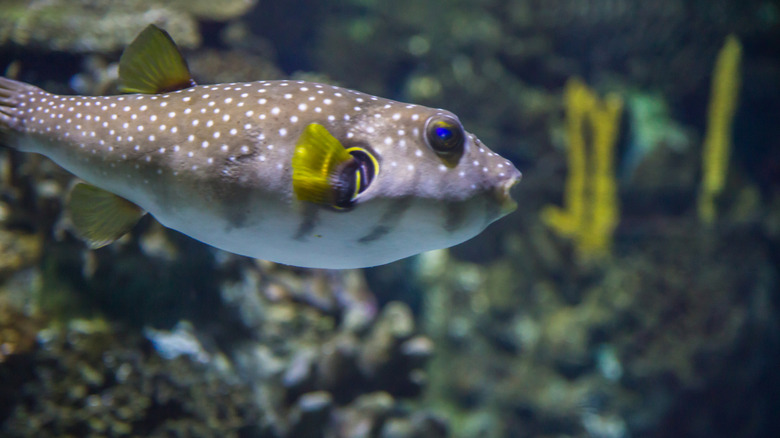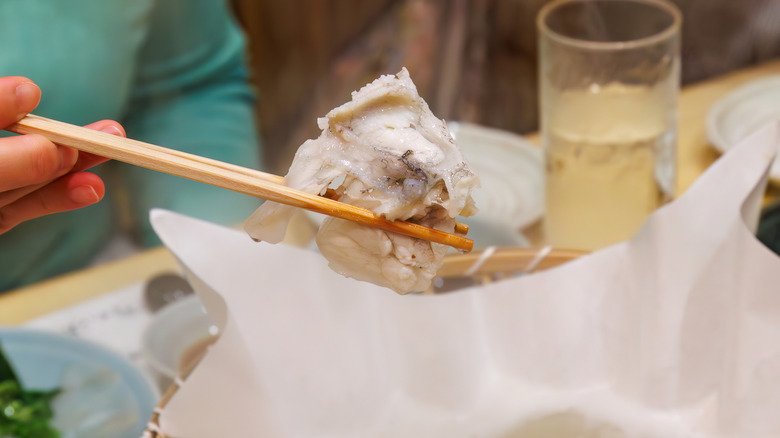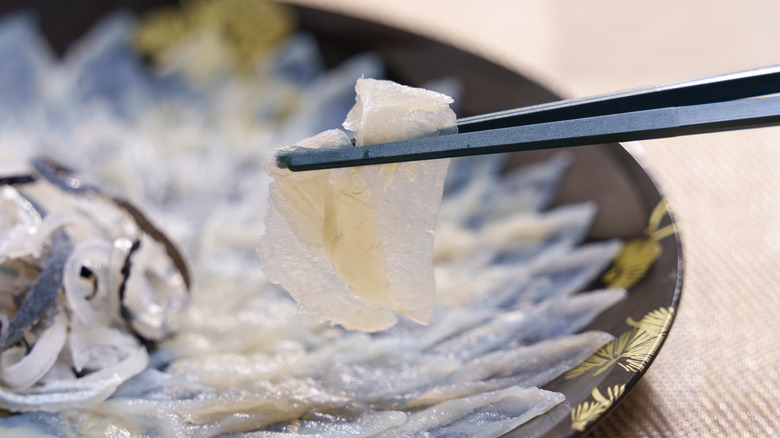Why You Don't See Blowfish On Sushi Menus
Some fish are ubiquitous in the world of sushi and sashimi. Some sushi-menu staples include salmon, yellowtail, and saba (or mackerel), which is often preserved in vinegar before being served. These fish are wonderful one and all, and most of them are not just found on practically every sushi menu but also often readily accessible for would-be sushi chefs to try their hand at preparing them at home. Then there are those rare fish that you'll find at higher-end sushi joints: hokkaido uni (or sea urchin), the amberjack (with its buttery yet firm flesh), and the prized maguro (bluefin tuna). But there's one fish that you won't find anywhere on menus, and certainly not at your local fishmonger: The blowfish, or fugu, as the Japanese know it, and you should never use it for sushi.
This unassuming little fish has become notorious among sushi enthusiasts, and it is an iconic dish in Japan. That notoriety comes mainly from the fact that if not prepared properly, it's poisonous. Not just poisonous, in fact, but deadly. The skin, liver, ovaries and intestines of the fish are full of tetrodotoxin, a powerful chemical that's allegedly over 200 times deadlier than cyanide. The tiniest mistake in blowfish preparation could lead to the contamination of the flesh — a potentially fatal error for the unfortunate diner who might end up eating it. As a result, it's mostly banned in the United States and much of the rest of the world. Even in Japan, the country's health ministry says that a few people die from incorrectly prepared fugu per year.
How to enjoy it safely
For those brave sushi enthusiasts who fancy trying some of this fabled fish for themselves, there are only really two options. If you're in the United States then the fish isn't entirely illegal, but it is remarkably difficult to track down. This is, primarily, because of the qualifications you need to actually prepare fugu in the first place — it's a process that takes over three years and involves a series of particularly rigorous tests. Unsurprisingly, most Japanese fugu chefs start in their teens.
Because so few chefs in the U.S. are qualified to serve blowfish, you'll only find it at the highest end of the sushi restaurant spectrum: The Michelin-starred restaurant Suzuki and the infamous Bar Masa, both in New York, have been known to serve fugu. In Europe, meanwhile, the sale of the fish is completely banned, so you won't find it on any menu, anywhere. If you want to get your hands on some, your best bet is to go to the source: Japan.
All the qualifications needed to become a licensed fugu chef mean that if you do go to Japan, contrary to popular belief, eating the fish isn't a particularly hazardous thing to do. The regulations are so strict that as long as your chef is both properly licensed (and adequately experienced), you'll be able to rest easy (if you can bring yourself to) knowing that your blowfish has been properly prepared. Just do your research and eat away — if you dare.
How fugu is prepared
Though you may not be able to get blowfish for yourself or at a restaurant (at least not without a plane ticket also included in the price,) the process of breaking down a blowfish is a fascinating insight into the skill of a master sushi chef. So, how is it done? Firstly — don't try this at home. Seriously. Nearly every death that results from eating fugu happens when unlicensed amateurs try to prepare it themselves, so don't be tempted to give it a go!
Though there are many variations of the blowfish, the most commonly eaten is the tiger pufferfish, or torafugu. It's slightly less toxic than other species and equally delicious when prepared properly. First, the skin is removed, then the fish is cleaned. Under the skin is a layer of (slightly gross) jelly, which needs to be carefully washed off using salt and clean water. Then, the fish can be gutted. This is the most crucial part of the entire process — the liver, ovaries, and intestines of the fish are its most toxic parts, and even the slightest rupture can contaminate the flesh with deadly poison. Once the guts are out of the way, the fish can finally be filleted and sliced for sashimi. If you're truly desperate to try blowfish for yourself, the northern blowfish, which can be found in North America, is non-toxic — and delicious when fried!


